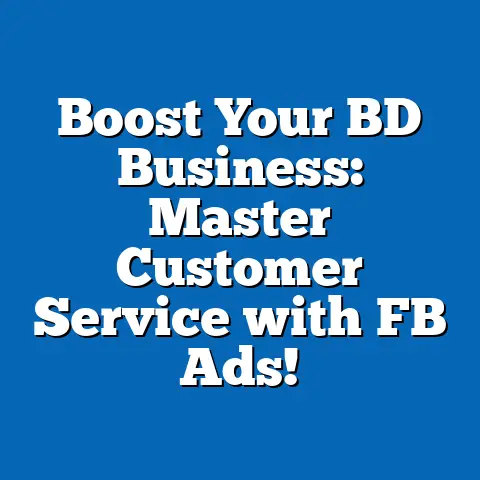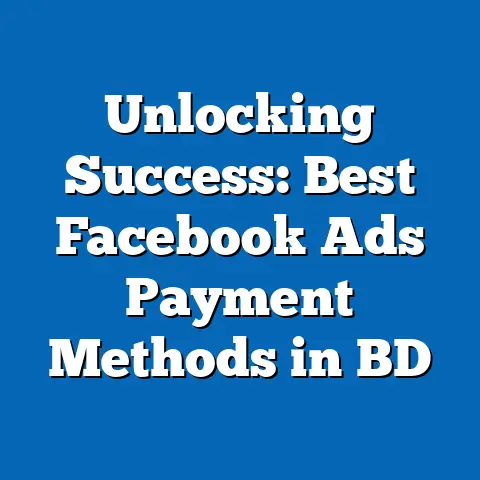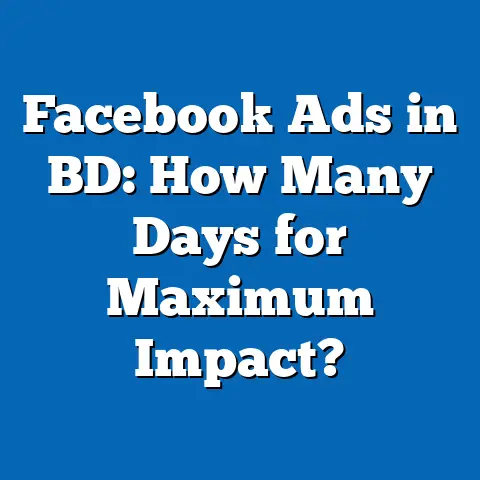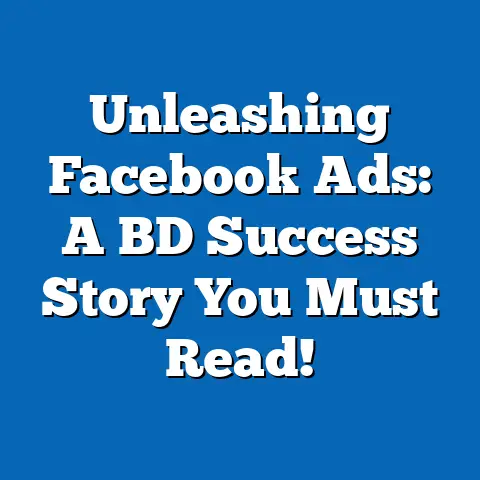Boost Your Boutique Sales: Facebook Ads for Women’s Fashion in BD!
Boost Your Boutique Sales: Facebook Ads for Women’s Fashion in BD!
When I first started marketing my boutique, I was obsessed with finding the perfect waterproof options for my customers. Bangladesh’s monsoon season is no joke, and women want fashion that not only looks great but stands up to the rain. I vividly remember launching a campaign featuring waterproof kurtis designed specifically for Dhaka’s rainy days. The initial excitement was high, but sales didn’t immediately reflect the interest. That’s when I realized that running Facebook ads without understanding the numbers behind them is like walking through a storm without an umbrella.
From that moment, I decided to master Facebook advertising metrics—numbers that help you decode what’s really happening with your ads. Over time, this deep dive into metrics transformed my boutique sales and helped me reach the right audience effectively. In this article, I share everything I’ve learned about Facebook ad metrics and KPIs that matter most for women’s fashion boutiques in Bangladesh, especially when promoting practical yet stylish products like waterproof clothing.
Understanding the Importance of Metrics in Facebook Advertising
Marketing on Facebook is not just about posting pretty pictures or flashy videos; it’s about measuring performance and making decisions based on solid data. For small and medium-sized businesses (SMBs) in Bangladesh, where budgets are tight and competition is fierce, every Taka spent must bring a real return.
I’ve seen many boutique owners focus only on likes or comments, thinking that means success. But trust me, those are vanity metrics—they don’t always translate into sales. The true power lies in understanding actionable metrics like reach, conversions, ROAS, and more.
Let me walk you through these key metrics one by one, explaining what they mean, why they matter, how to interpret them, and how they connect to your business goals.
1. Reach: How Far Does Your Message Travel?
Definition:
Reach is the total number of unique people who see your ad at least once.
Why Reach Matters:
For a women’s fashion boutique in Bangladesh, especially when launching something niche like waterproof kurtis or trendy winter shawls, reach is your first chance to make an impression on potential customers. The more people who see your ad, the higher the chances of attracting new buyers.
When I started with limited reach campaigns focusing only on Dhaka city center, my sales plateaued quickly. Expanding reach to suburbs and neighboring cities brought a fresh wave of customers.
How to Interpret Reach:
- If reach is low despite a good budget, it may suggest your targeting is too narrow or your ad isn’t approved fully.
- A rise in reach should coincide with increased engagement and hopefully conversions.
Relation to Other Metrics:
Reach is the foundation—without enough people seeing your ad, metrics like CTR or conversions won’t be meaningful.
Practical Tips for Increasing Reach:
- Use broad targeting initially but add exclusions to avoid irrelevant audiences.
- Utilize local interests such as “Bangladeshi fashion,” “monsoon wear,” or “Dhaka shopping” to refine reach.
- Leverage Facebook’s Lookalike Audiences based on your existing customer database for more relevant reach.
Real-Life Example:
I once ran a campaign targeting women aged 18-35 interested in ethnic wear during Eid. Initially targeting Dhaka only gave me around 10,000 reach daily. By expanding targeting to Chittagong and Sylhet while keeping similar interests, reach grew by 3x within a week—and sales followed.
2. Impressions: How Often Is Your Ad Seen?
Definition:
Impressions count how many times your ad was displayed on screens, including multiple views by the same person.
Why Impressions Matter:
High impressions with low reach mean your ad is shown repeatedly to the same audience. This can build brand recall but risks overexposure or “ad fatigue.” Low impressions might indicate budget or bidding issues.
Interpreting Impressions and Frequency:
The key is balancing impressions with frequency (impressions ÷ reach). For women’s fashion boutiques in Bangladesh, I found that a frequency between 2–4 strikes the right balance—your audience sees your ad enough to remember it but not enough to get annoyed.
Relation to Other Metrics:
High impressions combined with low CTR might mean your ad creative is not engaging enough despite visibility.
Local Market Insight:
In Bangladesh’s crowded Facebook space during festivals like Pohela Boishakh or Eid, impressions spike across all advertisers. To stand out, I adjusted my ad timing and creative style to break through the noise even with similar impressions.
Example:
When I launched waterproof shawls during winter, impressions were high but CTR was low because the creative didn’t showcase the product’s practical benefits well. After changing images to show customers using the shawls in rainy weather, CTR doubled even though impressions stayed constant.
3. Click-Through Rate (CTR): Measuring Engagement Quality
Definition:
CTR is the percentage of people who clicked on your ad out of those who saw it. CTR=(Number of ClicksImpressions)×100\text{CTR} = \left(\frac{\text{Number of Clicks}}{\text{Impressions}}\right) \times 100
Why CTR Is Crucial:
CTR reflects how compelling your ad is in motivating users to take action. For boutiques selling women’s fashion in Bangladesh, a good CTR means your message resonates culturally and visually.
Interpreting CTR:
- A low CTR (<1%) often indicates poor targeting or unappealing creatives.
- A high CTR (above industry average ~2%) suggests strong relevance but beware—clicks don’t guarantee sales.
Relation to Other Metrics:
CTR links your ad’s visibility (impressions) to user interest (clicks). Low CTR impacts Cost Per Click (CPC) as poorly engaging ads cost more per click to show.
Practical Example From My Experience:
Initially, my ads showing generic fashion models had average CTR around 0.6%. After switching to locally styled outfits featuring Bengali women celebrating traditional festivals while wearing waterproof kurtis, CTR jumped to 1.8%. The local touch made all the difference.
Local Idiom Insight:
In Bangladesh we say “মাটি থেকে আকাশ পর্যন্ত,” meaning from ground to sky—your CTR should aim high like that!
4. Cost Per Click (CPC): Managing Your Ad Spend Effectively
Definition:
CPC is what you pay on average for each click on your ad. CPC=Total Ad SpendNumber of Clicks\text{CPC} = \frac{\text{Total Ad Spend}}{\text{Number of Clicks}}
Why CPC Matters:
A low CPC means you attract clicks efficiently without draining your budget. For small boutiques in Bangladesh, controlling CPC is key since advertising budgets tend to be modest.
How to Interpret CPC:
- High CPC may mean intense competition for your target audience or irrelevant ads.
- Low CPC shows ads are well-targeted and engaging.
Relation to Other Metrics:
CPC combined with CTR gives insight into ad efficiency. High CTR + low CPC = excellent ad performance.
Tips for Lowering CPC:
- Target niche interests such as “Bangladeshi women’s fashion bloggers” or “Eco-friendly clothing.”
- Adjust bidding strategies—use manual bidding if automatic bids push CPC too high.
- Use A/B testing on creatives and headlines to find what drives cheaper clicks.
Case Study From My Campaigns:
By focusing on Dhaka and Chattogram metro areas during rainy months for waterproof kurti ads, CPC dropped from BDT 15 per click to BDT 9 per click—a 40% saving that allowed scaling up budget without extra cost.
5. Conversion Rate: Turning Interest Into Sales
Definition:
Conversion rate is the percentage of users who take your desired action after clicking an ad (e.g., purchase). Conversion Rate=(ConversionsClicks)×100\text{Conversion Rate} = \left(\frac{\text{Conversions}}{\text{Clicks}}\right) \times 100
Importance of Conversion Rate:
In Bangladesh’s e-commerce scene, conversion rate reveals how well your website or landing page closes sales after generating interest.
How to Interpret Conversion Rate:
- Low conversion rates (<2%) often point to website issues like slow load times or complicated checkout.
- High rates (>5%) show a smooth buying process aligned with customer expectations.
Relation With Other Metrics:
Conversion rate coupled with CTR tells how efficient your funnel is—from attracting clicks to closing sales.
Local Considerations:
Many Bangladeshi customers prefer cash-on-delivery (COD). Offering COD increased my boutique’s conversion rate by nearly 30% during Facebook campaigns because payment barriers dropped significantly.
6. Cost Per Conversion (CPCo): Measure Profitability Per Sale
Definition:
Cost per conversion shows how much you spend per actual sale or lead from Facebook ads. Cost Per Conversion=Total Ad SpendNumber of Conversions\text{Cost Per Conversion} = \frac{\text{Total Ad Spend}}{\text{Number of Conversions}}
Why It Matters:
It directly affects your profit margin. If cost per conversion exceeds average order value (AOV), you’re losing money advertising.
How to Interpret CPCo:
- High CPCo means inefficient ads or sales funnel.
- Low CPCo signals you’re spending smartly and scaling profitably.
Relation With Revenue Metrics:
CPCo combined with ROAS clarifies if you’re making money or just spending without returns.
7. Return on Ad Spend (ROAS): The Bottom Line Metric
Definition:
ROAS calculates revenue generated for each Taka spent on Facebook ads. ROAS=Revenue from AdsAd Spend\text{ROAS} = \frac{\text{Revenue from Ads}}{\text{Ad Spend}}
Why ROAS Is King:
ROAS directly shows if your campaigns are profitable. For boutiques in Bangladesh competing against large brands online, a ROAS above 3 is considered healthy because profit margins in fashion can be thin.
How to Interpret ROAS:
- ROAS < 1: You lose money. Time to optimize or pause the campaign.
- ROAS = 1-3: Break-even or slight profit; consider improving creatives or offers.
- ROAS > 3: Strong profits; consider scaling budget here.
ROAS Relation With Other Metrics:
High conversion rates combined with low cost per click usually lead to high ROAS. But always watch average order value because low-priced items require higher volume for profitability.
Local Case Study:
During Eid last year, I ran waterproof kurti ads targeting Dhaka and Chittagong markets with bundle offers. The campaign achieved ROAS of 4.2 due to high average order values combined with affordable ad costs—a rare but rewarding success in our competitive market!
8. Frequency: Avoiding Ad Fatigue
Definition:
Frequency measures how many times an average person sees your ad during a campaign period: Frequency=ImpressionsReach\text{Frequency} = \frac{\text{Impressions}}{\text{Reach}}
Why Frequency Matters:
While repetition builds familiarity (“আবারও দেখলো” – seeing again), too much causes annoyance (“বিরক্তিকর” – irritating). For fashion boutiques in Bangladesh where customers have many choices online, keeping frequency balanced keeps engagement healthy.
How to Interpret Frequency:
- Frequency < 2: Not enough exposure; increase budget or expand audience.
- Frequency 2-4: Ideal range for awareness and interest.
- Frequency > 4: Risk of audience burnout; refresh creatives or pause ads briefly.
Relation With Other Metrics:
Frequency impacts CTR and conversion rates negatively if too high due to user fatigue.
Practical Example:
In my waterproof kurti campaign during monsoon season, I noticed after frequency passed 5 times per person CTR dropped by half. After rotating new images featuring different models and styles every week, engagement revived dramatically.
Additional Key Metrics for Deeper Insights
Beyond these core metrics, here are other important KPIs I used that helped refine my campaigns further:
9. Engagement Rate
Definition:
Percentage of people interacting with your ad via likes, comments, shares out of total impressions: Engagement Rate=(Total EngagementsImpressions)×100\text{Engagement Rate} = \left(\frac{\text{Total Engagements}}{\text{Impressions}}\right) \times 100
Why It Matters:
Engagement shows how emotionally or socially connected your audience feels with your brand. For women’s boutiques in Bangladesh where word-of-mouth is powerful (“মুখে মুখে কথা”), this metric helps build community trust beyond direct sales.
How To Use It:
High engagement can drive organic reach without extra spend. Use engaging content like styling tips using waterproof kurtis or behind-the-scenes clips from local photo shoots.
10. Video View Rate (If Using Video Ads)
Definition:
Percentage of people who watched your video ad beyond certain time marks (3 seconds or more).
Importance:
Videos grab attention better but also need evaluation if people watch fully enough for messaging impact.
Audience-Specific Metrics for Better Targeting
For boutiques in Bangladesh especially targeting young women across different cities and rural areas:
11. Demographic Breakdown
Facebook reports performance by age group, gender, location:
- Helps identify which segments respond best.
- For example: Women aged 20-30 from Dhaka might convert more than older demographics.
- Tailor ads accordingly—for instance promoting waterproof kurtis heavily in rainy Sylhet region during monsoon season.
12. Device Usage
Knowing if users access ads via mobile or desktop helps optimize landing pages accordingly for faster load times and better UX—critical since most Bangladeshi users browse on mobile data connections which can be slow.
Creative Testing: Use Metrics To Improve Your Ads Continuously
Running multiple creatives simultaneously allows testing which images, copy, or videos resonate best based on CTR, CPC, and conversion rate.
Example:
Testing photos showing models wearing kurtis indoors vs outdoors in rain resulted in outdoor shots winning by 25% higher CTR in my campaigns targeting Dhaka urban women.
Regular testing keeps campaigns fresh and combats “ad blindness” common among frequent Facebook users here.
Ad Scheduling Based on Data
Analyze when your target customers are most active online—early mornings before work or evenings after dinner seem best for Bangladeshi women browsing fashion content—and schedule ads accordingly for maximum impact at lower costs.
Practical Guide: Step-by-Step Application of Metrics for Your Boutique
- Setup Conversion Tracking:
Install Facebook Pixel on your site to track conversions accurately. - Define Clear Objectives:
Whether awareness (focus on reach & impressions) or sales (focus on conversions & ROAS). - Monitor Daily:
Check CTR & CPC early; pause underperforming ads fast. - Adjust Targeting:
Use demographic & behavioral data from Facebook analytics; refine based on best performing groups. - Test Creatives Often:
Rotate images & copy every week based on engagement & CTR data. - Optimize Landing Page:
Ensure fast loading times; simple checkout; mobile-friendly design critical for Bangladeshi shoppers relying on smartphones. - Calculate Profitability Weekly:
Track ROAS & cost per conversion; scale budget only on profitable campaigns. - Use Local Language & Culture:
Ads featuring Bengali language slogans & local festivals drive more engagement than generic English-only ads.
Summary Table of Key Metrics
| Metric | Definition | Target Range / Tip | Why It Matters |
|---|---|---|---|
| Reach | Unique people seeing ads | Higher is better but relevant | Builds brand awareness |
| Impressions | Total views | Balance with frequency | Measures exposure frequency |
| Frequency | Avg views per user | 2–4 optimal | Avoids ad fatigue |
| CTR | Clicks ÷ Impressions | >1% good; >2% excellent | Shows ad relevance & engagement |
| CPC | Cost per click | Lower preferred | Controls budget efficiency |
| Conversion Rate | Conversions ÷ Clicks | >2% typical; >5% excellent | Measures sales funnel effectiveness |
| Cost Per Conversion | Spend ÷ Conversions | Less than average order value | Measures profitability per sale |
| ROAS | Revenue ÷ Spend | >3 profitable | Measures overall campaign success |
| Engagement Rate | Interactions ÷ Impressions | Higher preferred | Builds brand loyalty & organic reach |
Final Thoughts: Making Data Work for Your Boutique Growth
Facebook advertising can transform your women’s fashion boutique in Bangladesh—but only if you understand what the numbers tell you. When I focused on these metrics—especially tailoring my campaigns around local needs like waterproof fashion—I saw steady growth even amid tough competition and seasonal challenges.
Remember:
- Don’t get lost chasing vanity metrics like likes alone.
- Use data-driven insights from reach down to ROAS.
- Adapt creatives and targeting based on metric feedback regularly.
- Always think about local context—language, culture, payment preferences—to connect authentically with Bangladeshi customers.
- Most importantly: test continuously and optimize based on results rather than assumptions.
By mastering these metrics and applying them thoughtfully, you can boost your boutique sales significantly through Facebook ads while making every Taka count!





